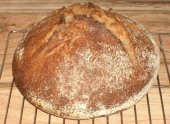




 1
1





 1
1














The ultimate goal of farming is not the growing of crops, but the cultivation and perfection of human beings. - Masanobu Fukuoka




 1
1




 I've also scraped some very black parts off too.
I've also scraped some very black parts off too. 



 2
2








Casey Homecroft wrote:
[i](this is where I love using a scale in the kitchen... because I hate measuring out flour the "correct" way. You know, spooning it into a measuring cup one cup at a time and leveling it off with a knife. It takes too long and always gets all over the place.




Len Ovens wrote:
most bakers consider the scale the "correct way" to measure flour.
 I love my scale!
I love my scale!



















My Marxist Feminist Dialectic Brings All The Boys To The Yard!
 1
1




 1
1




For unlimited return on all your investments - Make your deposits at 'The Entangled Bank' !




Gray Simpson wrote:I finally decided to throw out my starter and get some from Friends of Carl. Also, I made a loaf the other day in my crock pot and it came out great, with a nice thin crust.












Kylie Harper wrote:I wanted to share a couple of bread recipes. You'll be amazed at how simple & fast they are!!
Beer Bread
 depending on who you talk to, beer came from bread making or bread came from beer making. The bakers seem to be the ones who think bread came from beer BTW.
depending on who you talk to, beer came from bread making or bread came from beer making. The bakers seem to be the ones who think bread came from beer BTW.



Patrick Mann wrote:http://scienceblogs.com/casaubonsbook/2012/04/whats_with_the_no-knead_bread.php




Been there, Seen that, and have the post cards to prove it.
Be Well, Be Safe, and Blessed Be...
http://rivenfae-wolfwoods.blogspot.com/




Rivenfae Wolf wrote:I had found a wonderful recipe on youtube for a no-knead sourdough bread here it is:
3 C of flour
2 C of warm water
1 C of starter
1t of salt
One more book I would suggest is "The Bread Baker's Apprentice" I don't recall the author, but for a book about making bread from yeast and wanting to do it by hand it's wonderful to "work your way through". One of these days I might get to replace my copy of it, Happy baking!












Gray Simpson wrote:My crockpot "pumpernickel" was a failure. I let the dough ferment for 24 hours total because I only had a couple tablespoons of starter. That made it too sour to eat an entire slice, plus I always seem to make the dough too wet and it sticks to the pan. Anyway, I'm learning a lot about bread!








Carrie Stought wrote:I have tried several times to make wheat bread but it always come out hard and dry. Any suggestions?





For unlimited return on all your investments - Make your deposits at 'The Entangled Bank' !








Our inability to change everything should not stop us from changing what we can.




"A society grows great when old men plant trees whose shade they know they shall never sit in."



















|
If we don't do the shopping, we won't have anything for dinner. And I've invited this tiny ad:
Freaky Cheap Heat - 2 hour movie - HD streaming
https://permies.com/wiki/238453/Freaky-Cheap-Heat-hour-movie
|






